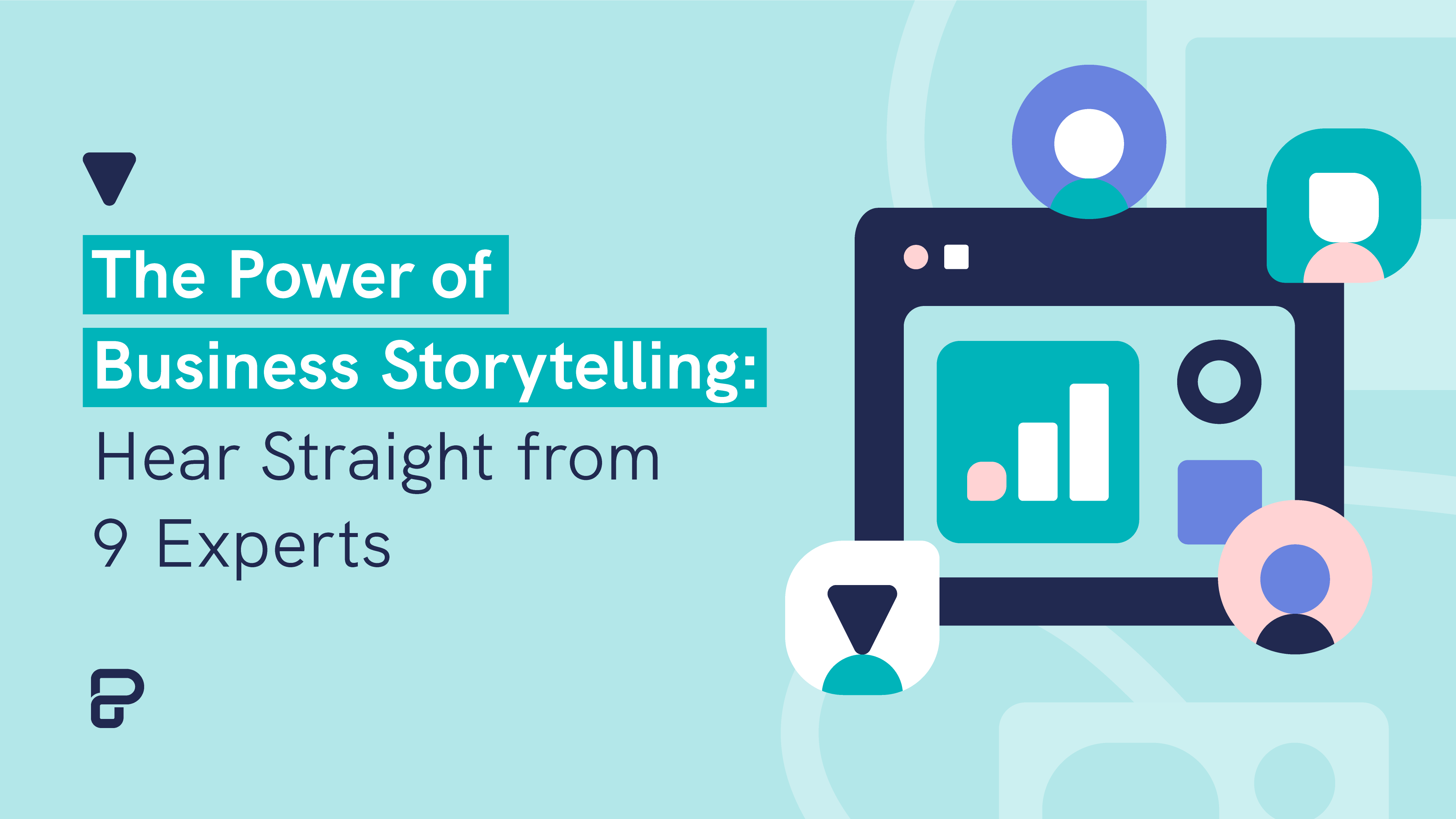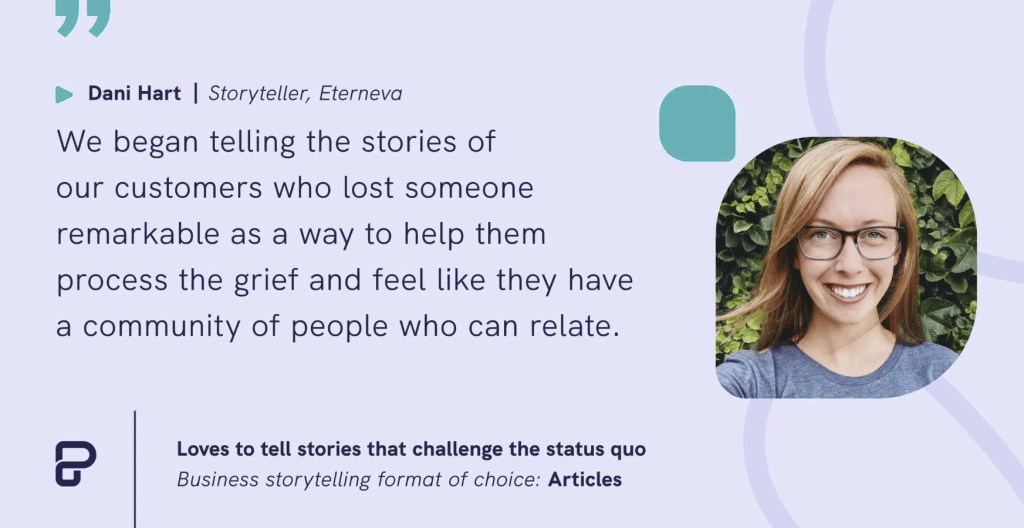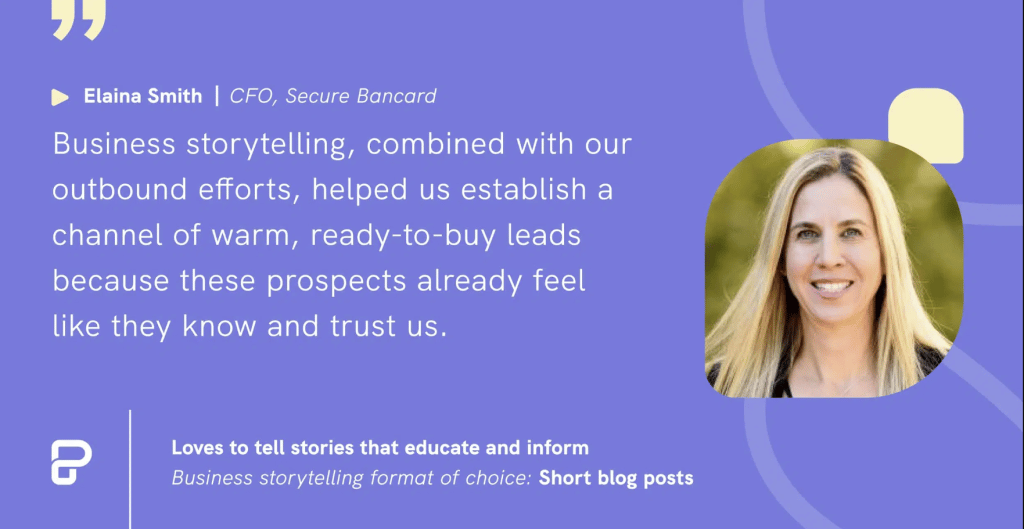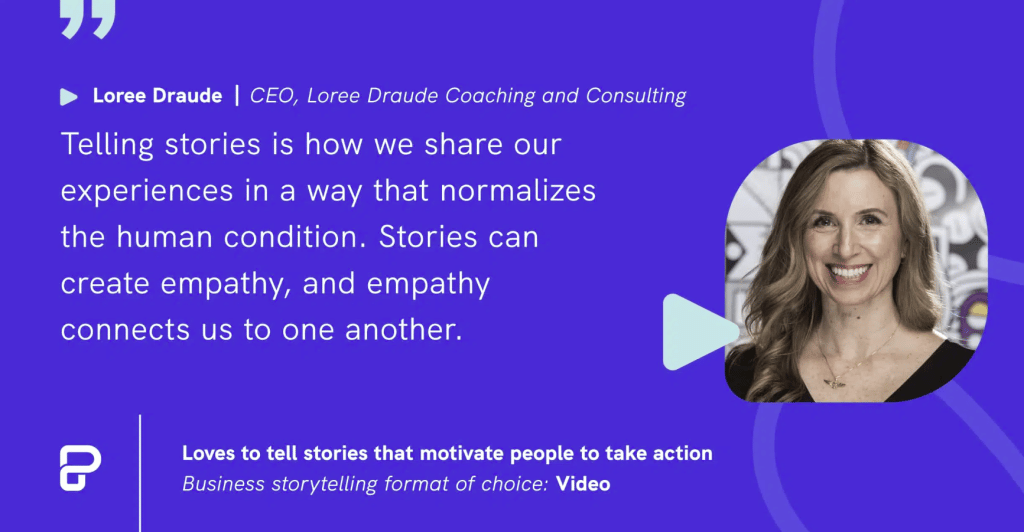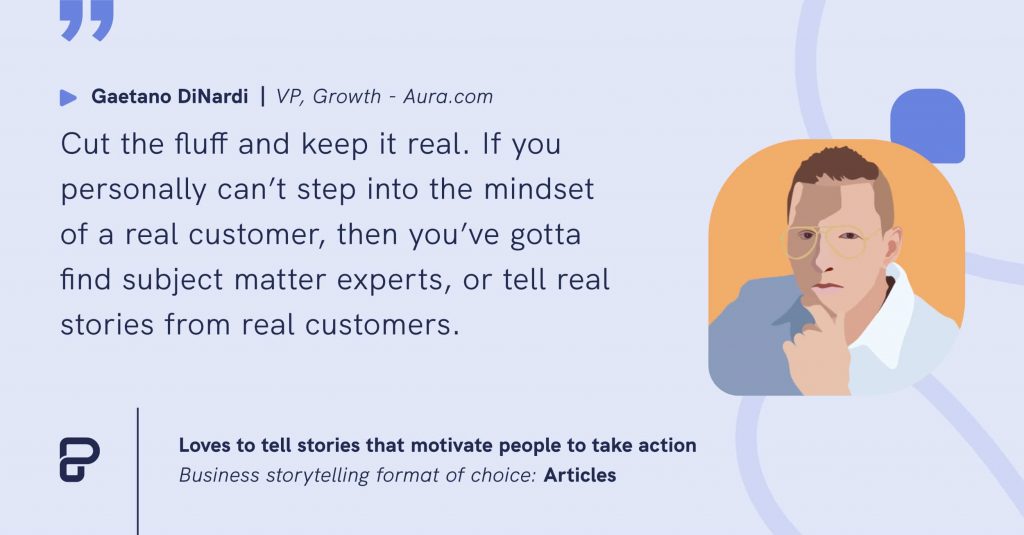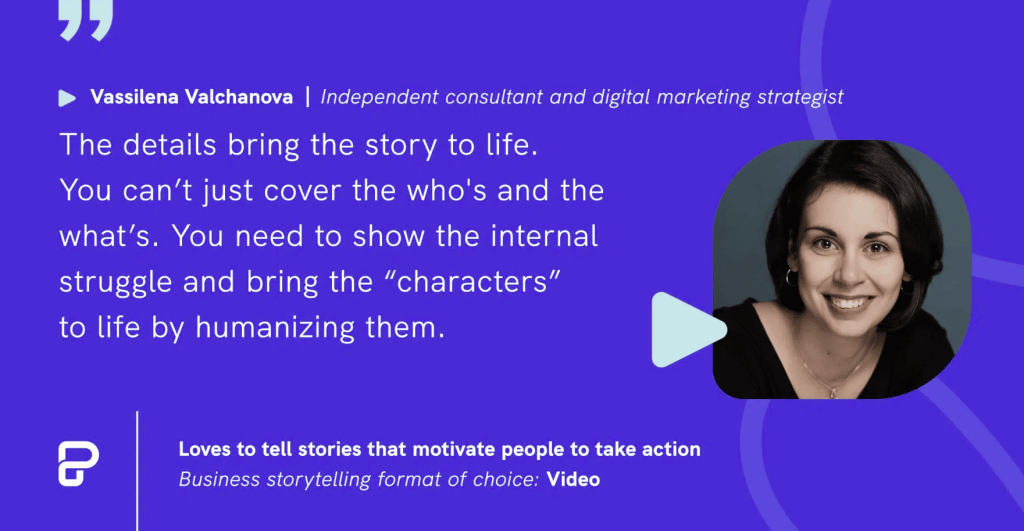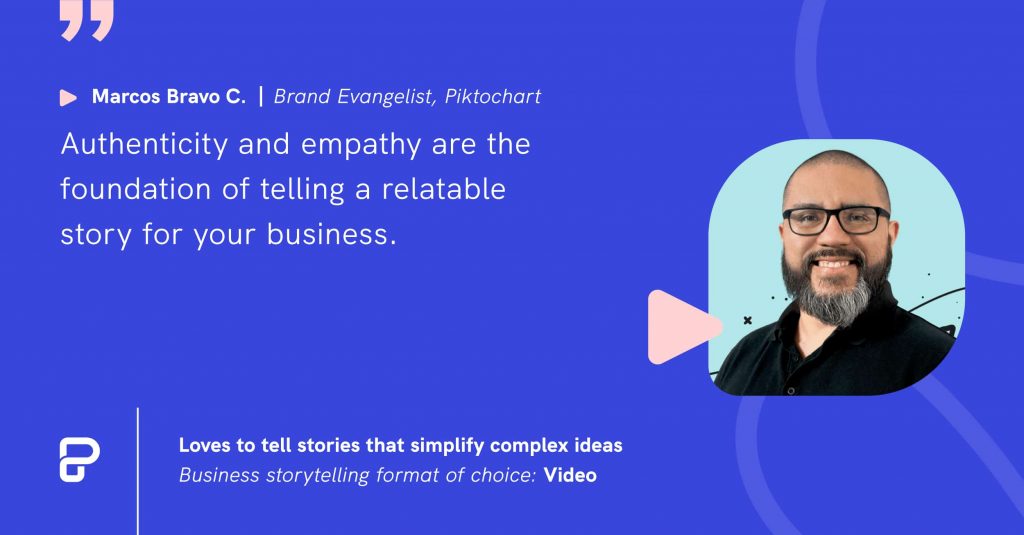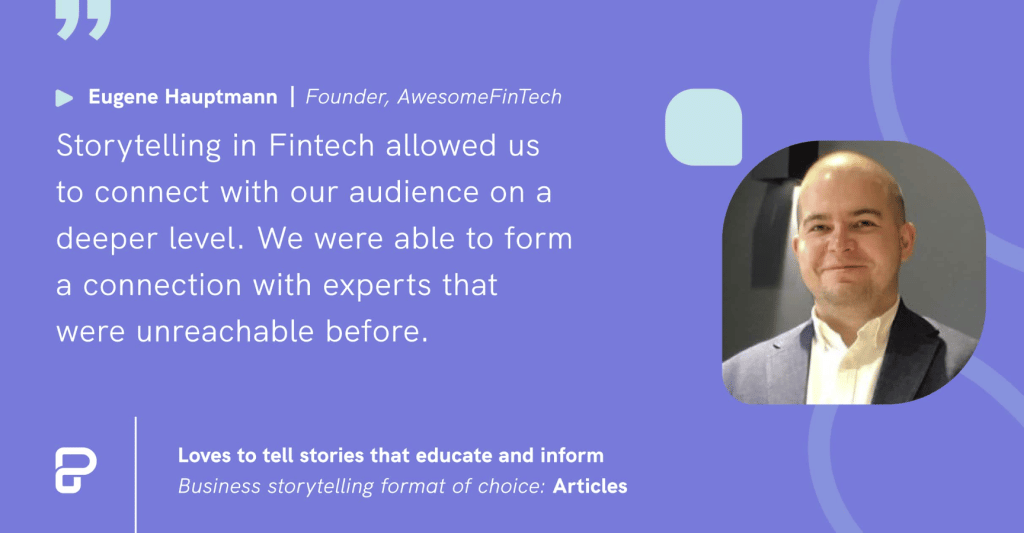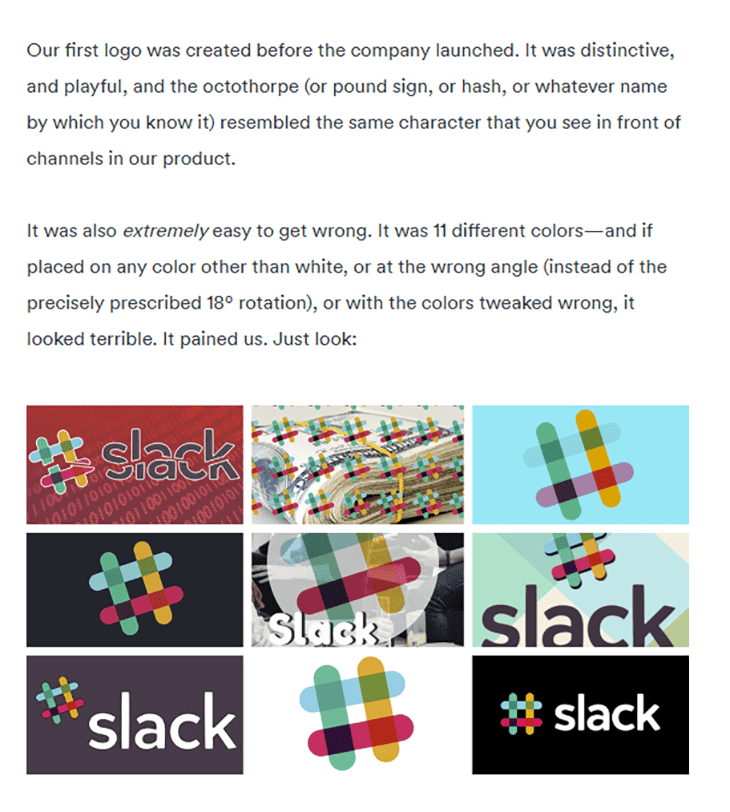Storytelling has become a business buzzword for the past few years. You’re probably tired of listening to everyone’s ideas (from business people to PR professionals) about how to write stories that engage, stories that sell to your audience, storytelling archetypes, and everything in between.
But there’s a reason why businesses are still enamored with the art of storytelling — writing stories will never go out of style.
A good story will make you feel something, but a great story, with brilliant writing, in the right context, will move you to take action.
Expert Tips and Advice on How To Become a Master Business Storyteller
While storytelling is hailed as the biggest business skill that everyone (not just marketers!) should work on in the coming years across the world, there’s still much room for improvement for most of us when it comes to telling stories that answer key questions.
We’re talking about brand or business stories that spark curiosity, make emotional connections, and persuade people to take action.
Get ready with your pencil, pen or notes app as we zoom in on the power of business storytelling, how you can use it to stand out in a crowded market space, and win over customers.
At Piktochart, we have business storytelling experts from various industries and niches worldwide on speed dial, and phoned in some favors to write this guide. They were generous enough to give us some of their time to impart great advice to you within the context of the article, including plenty of examples.

Let’s dig in. You can also skip to a specific section to get started:
Try Piktochart for free and tell better stories with visuals + video for your business and beyond.
Wait, What’s Business Storytelling?
Business storytelling is the process of sharing relatable stories instead of facts and figures with your audience.
Compelling stories can communicate to and connect with employees, customers, collaborators, partners, and everyone else connected to your business. The purpose of business stories isn’t to provide amusement but rather to have a specific message, objective, and, ultimately, a wanted outcome.
Your prospects and customers are tired of being sold to. In fact, 3 in 4 people actively avoid advertising. They don’t want more sales pitches, promotional emails, and one-way conversations. These characters, your audience, are looking for a real connection with brands like yours.
“Business storytelling is a way to build a relationship with customers and help inspire others in the community while staying true to the mission and voice of the brand,” shares Dani Hart, Chief Storyteller at Eterneva, a deathcare and grief wellness brand.
“Our customers are usually grieving when they become a customer, we turn ashes into memorial diamonds for people and pets. We know that grieving is hard and sometimes very isolating.
We began telling the stories of our customers who lost someone remarkable as a way to help them process the grief and feel like they have a community of people who can relate.
Our goal with storytelling is to help inspire those who could use some inspiration as they enter a tough season of life.”
Learn more about business storytelling and why it’s important in this podcast episode with Piktochart’s VP of Growth – Agata Krzysztofik: What is Business Storytelling and Why It’s Important
How To Get Started With Great Storytelling for Your Business
You’re probably wondering — how do I get started with business storytelling?
Start by telling why and how your company was initially founded, how the original mission still influences everything the company does today, and explain your vision for the future.
Your business narrative should explain and answer the following questions:
- What motivates the company’s founders and its employees?
- What important problems were the company and its product created to solve?
- Why do buyers pick your brand over competitors?
By having something interesting to say to answer these key questions, your business narrative can capture the attention of potential customers and even motivate people toward the next action.
Every successful company today has a core business story integrated into every aspect of its organization — from customer service to sales.
For example, here’s how Mailchimp tells the story of its biggest value proposition: building an audience base.
The video’s unique and solid business narrative doesn’t just engage prospects but creates a connection that makes customers almost feel like they are part of a family, which is impossible for competitors to replicate.
The Importance of Business Storytelling
It’s easier to understand the importance of business storytelling in theory, but many still fail to put company stories into practice.
Let’s look at how a well-thought-out storytelling strategy benefits your company.
The short video below also highlights thoughts and insights from business leaders we’ve interviewed in The Business Storyteller Podcast and Business Storyteller Summit about the power of stories in branding, marketing, sales, and all aspects of a business.
1. Stories create, engage, and impact emotions
You might not realize it, but we, as humans, naturally gravitate toward things that are fun and pleasurable instead of actively seeking things that create painful experiences.
Studying hard facts, reading through written reviews, and comparing product offering features are examples of painful experiences for a consumer.
Of course, people pay attention to statistics and logic, but only after they’ve been reeled in by a moving brand story. For this reason, leading with a good story is always a better proposition than bombarding your audience and prospects with a sales pitch.
Imagine you’re selling an online course that teaches people how to use MS Excel. Maybe you’ll be surprised to hear this, but there aren’t many people who just wake up one day and think they have to master spreadsheets. It’s not the product that they really care about, but the service and process behind how they get there.
Depending on your target customer, if you sell them on the story of how someone who knows MS Excel gets to impress their boss and earn the respect of colleagues, you are more likely to capture their attention and get them to sign up for your course.
Expert tip by Dani: “Never forget who you are talking to, and sometimes that means doing more of the listening than the talking. Listen to your customers, learn from their experience, and speak to their pain points.”
2. Stories impact the bottom line
If prospects were 100% logical, they would weigh the pros and cons of different options in the market and pick a product or solution accordingly. But we all know this is not how it works.
Think about the automotive industry, and a branded car company commercial. Do they show you the car specifications and innovative engineering features behind their latest model? No, car commercial stories largely aim to evoke an emotional reaction from their viewers via feelings of freedom, impulsivity or safety.
Humans are creatures of both emotion and logic. Research by Origin and Hill Holiday shows that people spend more money on company products when they are associated with a story context, no matter what that story may be. This brings a whole new level of psychology to the forefront of consumer behavior, which must be considered to effectively sell your brand and offerings.

“Stories drove results for us. We use the SpaceX story (the company started as a school for kids of SpaceX employees) in our customer stories. It got us conversions from FB Ads,” shares Aazar Ali Shad, Growth Marketer at Synthesis, a B2C SaaS targeting parents.
In a nutshell, compelling stories play a significant role in your prospects’ purchase decisions.
Expert tip by Aazar: “Start early. Make your founder’s story powerful.”
3. Stories are easy to remember
We can easily recall stories because they actively involve our emotions.
If you try to remember a sad story, or any moving story from your childhood for that matter (i.e., Toy Story), you’re likely to remember how you felt (sympathy, dread, happiness, euphoria, etc.).
Meanwhile, a plain statistic is hard to remember on its own, but once put into the context of a story, people are 22 times more likely to remember it.
4. Stories help your brand stand out
Storytelling becomes even more important if you sell a commoditized product in a competitive market.
If many brands are selling products with similar features to yours, what other way do you have to differentiate yourself than a compelling story to resonate with your audience?
Take it from Elaina Smith, CFO of Secure Bancard, a B2B payments provider:
“The payments industry is a sea of sameness in terms of marketing. It was important to differentiate ourselves and connect with our audience in an authentic way.
We decided to share the backstory of our business, the world of payments, and the people in it.
Business storytelling, combined with our outbound efforts, helped us establish a channel of warm, ready-to-buy leads because these prospects already feel like they know and trust us.”
The bottom line: A good business story makes you and your new idea different from the rest, as well as helps you stand out in the mind of your audience or customers.
Expert tip by Elaina: “First, identify who you are trying to connect with. Then, think about the things that they care most about. Tell stories shaped around these themes in your authentic voice so that they can easily feel a connection with your content.”
5. Stories help you build trust
Consumer trust is the currency of today’s businesses.
To further illustrate this point, Loree Draude, CEO of Loree Draude Coaching and Consulting, shares how storytelling helped her team build trust with their clients:
“Sharing stories about my own experiences and struggles can feel scary, but it connects me to my clients because they know I’ve shared many of the same struggles they’re going through. This connection builds trust and allows them to dig deeper during our coaching sessions, enabling transformation and growth.”
Expert tip by Lauree: “Read about the Hero’s Journey. It’s a standard template for stories. Know your customers well enough that you can craft a story they can identify with, where they are the hero of the story.”
Bonus tip: Watch the video below for more insights on The Art of Inspiring Trust and Loyalty with Your Story
6. Stories drive people to take action
Stories are powerful, persuasive tools.
When you can persuade your prospects and customers, they will support your business in any way they can.
Aura‘s VP of Growth, Gaetano DiNardi, has a story (so meta?!) to tell on this specific benefit of business storytelling:
“We are in an industry (digital security) where people don’t want to take action. Everyone knows about identity theft, and they know it’s a problem. But they don’t think it can happen to them. It’s similar to car accidents. No one thinks about it until it’s too late.
Business storytelling isn’t about sitting on a campfire passing roasted marshmallows around. You’re taking the customer’s mind somewhere real. You use real-life examples and use cases to present a problem and explain the solution.”
Expert tip by Gaetano: “Cut the fluff and keep it real. If you can’t step into the mindset of a real customer, then you have to find subject matter experts, or tell real stories from real customers. That’s the only way.”
The Elements of Business Storytelling
Business storytelling isn’t just about creating lots of product-centric content. Yet many organizations are still inflicted with the quantity over quality approach.
You don’t have to sacrifice effective storytelling in favor of sales-oriented content that doesn’t relate to the audience, you can dig deeper and share the core message of your business narrative. Crafting a great story boils down to the following key components.
1. Emotion
Emotional appeal is at the heart of all good stories. Domino’s restaurants, for example, are not just selling pizzas. They’re selling the story of having good, quality time with friends and family.
If you can generate a positive emotion in the first few seconds of reading a blog post or watching a video, your audience will get hooked to your story, inspire action, and in turn, you’ll see increased sales.
Vassilena Valchanova, independent consultant and digital marketing strategist, has some great advice to become a good storyteller:
“The details bring the story to life. You can’t just cover the whos and the what’s – you need to show the internal struggle, bring the “characters” to life by humanizing them, and focus on the emotions.”
2. Simplicity
Complicating the core message is one of the biggest mistakes brands make when telling their story.
For a persuasive story, keep it simple and easily digestible.
Basecamp’s landing page, for example, is living proof that it’s possible to tell a simple narrative even for a complex product.
It uses a “before-after” story formula to drive the point that using the software leads to peace of mind and freedom from worries related to the progress of your projects.
3. Authenticity
The stories you create should be real, open, and transparent.
86% of consumers agree that authenticity is one of the key aspects they consider when evaluating brands.
“Authenticity and empathy are the foundation of telling a relatable story”, says Marcos Bravo C., brand evangelist at Piktochart and one of many great storytellers.
4. Meaning
Many businesses tend to focus on what they sell instead of what their buyers care about. Yet 71% of consumers purchase from businesses with values that overlap with theirs.
When crafting a brand story, it must be relevant to the prospects you’re targeting, forging a meaningful connection between your brand and customers.
How To Tell a Story That Resonates With Your Audience
Follow this step-by-step guide if you want to create and share stories that are true to your brand and your long-term company plans.
1. Pick good story ideas
There are many good stories beneath the surface of your business — you just need to grab a shovel and dig them out.
When thinking of business story concepts, it always helps to go over particular characteristics of your brand.
Here are some questions to help conjure up some ideas.
Who are you?
Reveal your true self to your audience.
According to Wunderman, 89% of Americans say they’re loyal to brands that share their values. You can demonstrate these values with stories that give an exclusive insight into your company culture, staff spotlights, personal favorites, etc.
Emilia Korczynska, Head of Marketing at Userpilot (B2B SaaS Product Growth Platform), shares the same thoughts:
“Business storytelling to me means having a personal conversation with our audience. Just as if I would when talking to my friend or partner, I talk to my audience, exploring product-related topics from my personal experience, peppering the stories with anecdotes and my authentic personality (read: a lot of puns and dad jokes!).”
Expert tip by Emilia: Don’t be afraid to be yourself – personality and authenticity go a long way.
A real-life brand story example is how, after 10 years in the business, we shared Piktochart’s humble beginnings and highlighted the most impactful lessons we learned for the past decade — 10 Lessons (And Counting!) from 10 Years of Bootstrapping
What do you do?
You already know what you offer. Think beyond the cliché sales lingo and dive deeper into the features of your product/service.
Are there any attributes that make your product stand out or increasingly convenient to people?
Here’s a good example from Emilia:
“We applied storytelling to our newsletters and individual LinkedIn accounts. We called our newsletter “Product Rantz”, a name that was actually invented by one of our subscribers (thank you Eli!) and we talk about product-related problems in a super-informal, conversational way there.
We have an open rate of 30% on an unsegmented list of over 7300 users. We also use personal LinkedIn accounts to share stories related to what we do. This helps us connect with our audience on a more personal level.
People actually see us as real people, and are more likely to engage with us, ask for help, and consider Userpilot as a solution for them.”
Who do you do it for?
Think about the people you want to serve. Why are you devoting your attention to them? How do you want to be of service to them?
Case in point: Old Spice’s “The Man Your Man Could Smell Like” campaign used humor to refresh the brand.
What made this story effective was the targeting. Market research conducted by the company revealed that women purchased 60% of men’s body washes. As a result, the brand crafted a story specifically to target women, and it worked. Sales went up to 60% from the year before.
Why do you do it?
According to Accenture, 52% of people are likelier to buy from brands that stand for something bigger than their products/services.
It doesn’t matter if you’re a 1-day-old small business or a 100-year-old mammoth organization, there’s a purpose behind your existence, and you’re likely working toward a cause that’s bigger than you.
If you sell home security devices, for example, your purpose is not just to protect people’s homes but give people a sense of safety and peace of mind that helps them live a secure and happy life.
How do you do it?
According to Sprout Social, 86% of Americans admit that brand transparency today is more important than ever. People love to know what happens behind the scenes.
If you use some proprietary technology, use unique materials, or have anything else about your process that makes you stand out, you can craft a story to let customers in on the secret. As a result, they’ll feel much closer to you and your brand.
2. Weave a holistic narrative
Once you have shortlisted the best story ideas, it’s time to develop them and turn each idea into a complete narrative.
At a basic level, every story should have:
- A beginning that introduces the main character and sets up a conflict or problem
- A middle point with rising action toward solving the problem
- An ending that covers the outcome of the action and shows what has changed in the character
Esther Choy, founder, and president at Leadership Story Lab, calls it the I.R.S.
“It stands for an intriguing beginning, riveting middle, and satisfying ending. If you remember this structure, you’re 50% there,” explains Esther in an interview about how business leaders can get better at storytelling.
“When planning for your narrative, think of a story in the context of a main character who wants to solve problems and overcome obstacles,” suggests Eugene Hauptmann, founder of AwesomeFinTech.
For example, consider how Slack weaved the story behind its logo change. The company had a problem.
Its logo was not working. The color scheme of its logo was hard to match with different backgrounds and other elements. But they couldn’t just change it in a flash as many users had been accustomed to the same.
As part of their storytelling efforts, they crafted a linear and transparent story that conveyed problems with the old logo, what they were doing about it, and what they hoped to achieve as a result. Their honest communication helped a lot of customers understand and accept the transition.
3. Bring your story to life in the right format
Every story needs to be communicated in the best way possible. Choosing the right format is essential to its consumption and distribution.
The most popular formats for business narratives include the following:
- Blog posts
- Videos
- Newsletters
- Presentations
- Infographics
- Case studies
- Comics
- Motion graphics

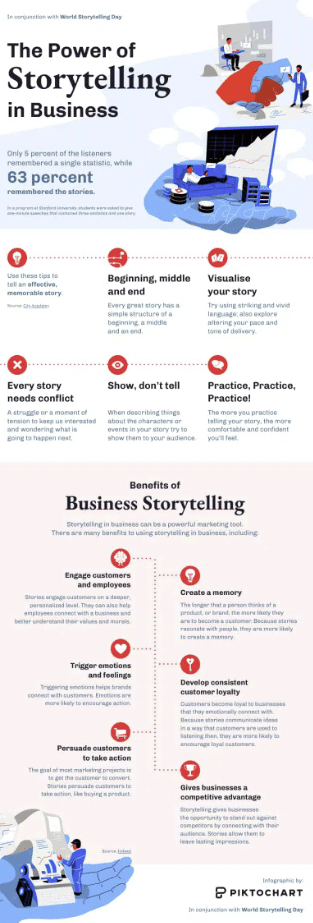
Creating presentations, infographics, and videos with a visual storytelling tool like Piktochart is a great way to cover a lot of formats. You don’t need high production standards or complicated software to create your business storytelling visuals. Try it for free.
4. Ensure alignment with your brand’s core message
Finally, ensure that your business stories align with your brand. They should reflect the ethos of your brand in the following key aspects:
Voice: Refer to your organization’s brand guidelines on brand voice and tone. If they do not exist, take the time to define your brand voice first. The brand voice will determine how your storytelling comes across to your audience. For example, your guidelines will indicate whether it should be fun and playful or formal and authoritative.
Visual style: Your brand’s visual style is what makes it memorable to prospects and customers. The story you share should be consistent with your brand style guide.
When you create a storytelling video with Piktochart, for example, you can customize aspects such as colors, fonts, background, logo, intro clip, and much more to match your brand

Make Your Business Narrative Work for You With Communication Skills & Consistency
When you take away the buzz and gimmicks of business stories, you’ll realize that it’s not a one-time effort. Business narrative consistency is a crucial part of good storytelling that works and delivers results.
If you don’t see the results you hoped for, stick to the principles and advice we have covered in this guide to master the art of business storytelling.
Eventually, you’ll get to a stage where you have a persuasive story that not only inspires and grabs the audience’s attention, but also prompts your listeners to support (and even advocate) your business.
If you’re looking for more resources on how to share a great business story, find additional resources to hone your storytelling technique below:
- The Business Storyteller Podcast by the Piktochart team – A series of conversations with inspiring leaders and entrepreneurs to share their knowledge and experience in storytelling for their businesses.
- Fundamentals of Visual Storytelling – A free course on everything you need to know to make great stories stick — from content, typography, and color psychology to images.
- Business Storyteller Summit on YouTube – A recording of 15 storytelling experts talking about effectively using storytelling to grow and influence. The speakers included founders, executives, marketers, and storytellers who have successfully used compelling stories to build thriving businesses, brands, teams, and products.
Editor’s note: This blog post is written by the Piktochart team in collaboration with content consultant Hitesh Sahni.
